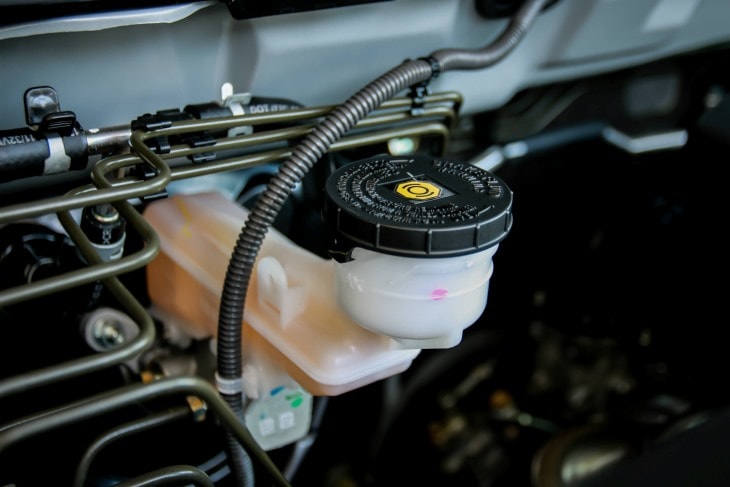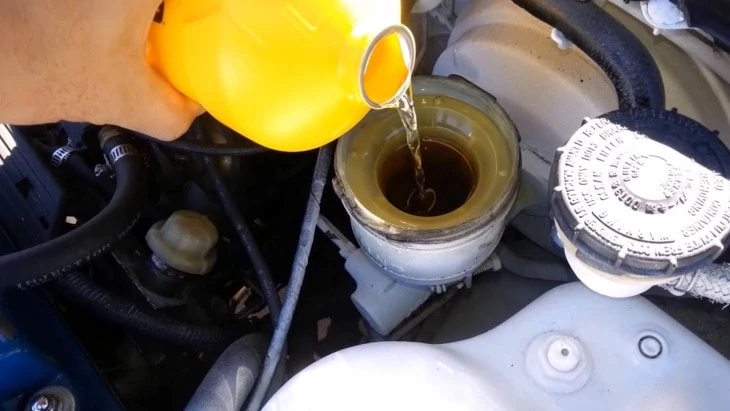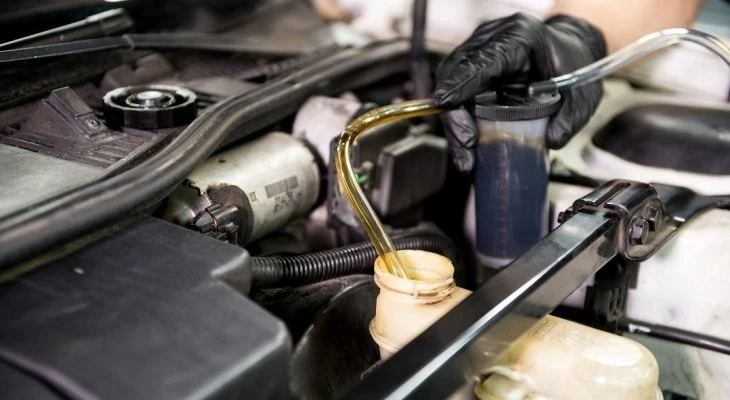Brake fluid is one of the reasons why your car stops when you push on the brake pedal. It helps turn the relatively delicate force you apply on the pedal into a force strong enough to stop the car.
Brake fluid is the chemical fluid used in the hydraulic braking systems of modern cars. Just like your engine oil, it needs to be replaced from time to time in order to ensure continued performance of the braking system of your car and to increase the lifespan of its components.
Depending on the model of your car, you’ll need around 1 liter (or 32 oz) of brake fluid for a complete flush, and around half that (500 ml or 16 oz) for a partial brake fluid flush. This will ensure that your car’s braking system maintains optimal performance without compromising safety.
What is a Brake Fluid Flush?

A brake fluid flush is a process by which the existing dirt and moisture-contaminated brake fluid is removed with caution and replaced with fresh fluid.
This service will ensure continued good performance of your brakes (even enhancing the braking function) and ensure that you can make your brake components last longer without a replacement.
How Often Should You Get a Brake Fluid Flush?
As a general rule, ask your mechanic to check your brakes and brake fluid during every oil change. They can give you the best feedback on how your brakes are working and if they need new fluid. For most cars, a brake fluid flush is required once every 2 to 3 years.
How Much Fluid Do You Need for a Flush?
Simple answer: it depends. You’ll need around 1 liter of brake fluid for a complete flush and around 0.5 liters (approximately 500 ml) for a partial fluid flush, depending on how dirty or discolored your brake fluid is. The murkier the fluid, the more fluid you may want to use for the sustained functionality of your car.
How Do You Know Your Brake Fluid Needs a Flush?
Brake fluid usually has a light, clear color. If it’s not clean or transparent and appears murky, it’s probably dirty and needs changing. Also, if your brake fluid falls below the “full line” level in the reservoir, it’s a clear indication that it either needs to be topped off or replaced.
Types of Brake Fluids
Brake fluids are broadly categorized into glycol-based and silicone-based fluids. The glycol-based brake fluids include DOT3, DOT4, and DOT5.1. The DOT5 brake fluid is silicone-based. DOT5 should NOT be mixed or used interchangeably with glycol-based brake fluids.
How Brake Fluids Work

You step on your brake pedal to force the small pistons in your brake caliper to compress, and the result is that you squeeze your brake rotors to slow down your car.
The brake pedal uses something called the brake line to connect to all four of your car’s brake rotors. This essentially diverts the force you apply on the brake pedal to all four corners of your car. These lines are filled with brake fluid- the essence of your braking system.
Brake fluid is a non-compressible, hygroscopic (which means “moisture absorbing”) fluid that allows all the energy that your foot releases onto your brake pedal to be converted into pressure applied to the brake rotors to slow them down.
The friction caused by the pressure creates a lot of heat and the brake fluid is immune to the change in temperature for a long time, which means that your brake fluid needs to retain its incompressible nature without damage caused by heat.
As with any kind of fluid used in combustion systems, your brake fluid will eventually need to be replaced. Overheating and boiling of the brake fluid over time creates air bubbles in the system, and eventually, your pedal pressing will only be compressing air. Which translates to “your brakes are not doing their job.”
To avoid this phenomenon, you need to go for a timely brake fluid flush!
Final Thoughts
Don’t underestimate the need for a fluid flush. It takes minimum time and resources and nothing is more important than your safety and well-being as a driver and a passenger.

